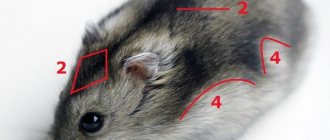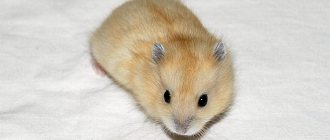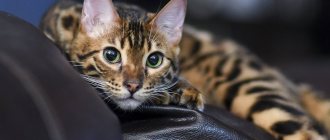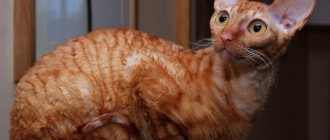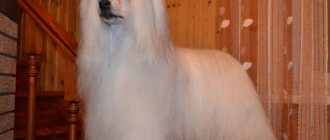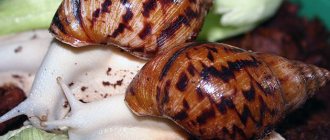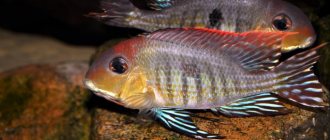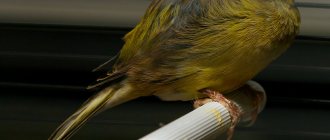Good day, dear friends! Do you have pets? For example, I have a huge red cat and, recently, two small kittens that were thrown to our fence.
But if you don't like cats and dogs, then you can buy a hamster. Many animal lovers like Djungarian hamsters because of their funny appearance.
This rodent is popular due to its cleanliness and ease of maintenance.
But, despite minimal efforts, do not forget that care and nutrition must be carried out taking into account certain rules.
If you do not take care of the animal, the hamster may get sick.
What is a Djungarian hamster like?
Before getting a pet, study in detail the information on how to care for it at home.
In the wild, the Djungarian hamster lives in steppe zones in Siberia, Khakassia and Kazakhstan. The tiny rodent is no more than 5-7 cm tall.
He does not emit an unpleasant odor and loves to be held. Remember that jungarians are active animals, and their energy manifests itself in the evening.
A special feature of this type of hamster is the dark stripe on its back. The rest of the fur may be brightly colored with white speckles.
Domestic hamsters can have the following colors: tangerine, standard, pearl and sapphire . In winter, the coat may turn white.
You can always see what the animals look like in the photo. Even at home, such hamsters store food for the winter, hiding it behind their cheeks. Do you know how long these animals live? Approximately 3 years. They can sometimes become aggressive and even bite.
This is something to remember, especially if you have children.
Djungarian hamster: features of communication with the animal
The Djungarian hamster, the photo of which is presented below, is a cute and harmless animal. But this little family member also has his own character and behavior. Here's what you need to know when establishing communication with Djungarians:
Relationships with relatives
Djungarian hamsters live alone in nature. If you want to get offspring, then take two rodents from the same litter. Even in this case, they may not get along with each other, and then battles are guaranteed. Dzungariks defend their territory aggressively and assertively, so they fight until there is blood. Keep this in mind if you decide to add a Djungarian or Syrian neighbor to your rodent.
What to name a hamster?
Now let's find out what to name your pet. Which name can you choose for a boy, and which one is more suitable for a girl? Nicknames for girls hamsters are divided into the following categories:
- character. If a rodent runs around and rustles a lot, then it can be called Shusha, if it shows friendliness, then affection, and if it sleeps a lot, then Sonya;
- wool color. The red hamster can be called Zolotets, Ryzhuley or Sunny. For white, Zhemchuzhina is suitable, and for black, Banira;
- food. You can name it by the name of the product - Raspberry, Marshmallow, Vanilla or Orange;
- stars. Name it after your favorite singer or actress. For example, Jessica, Britney or Lolita.
And here are the names for boy hamsters:
- color You can call the red one Apricot, Peach or Ryzhik, the gray one Gray, the white one Snowball, and the black one Coal;
- cartoons. Give the name of the cartoon character - Chip and Dale, Fixie or Smurf;
- sizes. Since hamsters are compact in size, they can be given the name Pupsik, Lilliputian or Gnome. You can give your tiny pet a cool name - Bulldozer, Gulliver or Beast;
- gastronomic delights. Give it a name: Mars, Glutton or Snickers;
- sport. Sports lovers can name their pet Sniper, Athlete or Schumacher.
Where is the best place for a hamster to live?
It is important to provide proper care for your pet. Cages are not the best place for him.
Plastic and wood rods will quickly be chewed off. A glass aquarium with a length of 100 cm and a height of 40 cm can be used as a mink. You should not purchase a smaller product, as the air circulation in it will be disrupted.
The bottom of the home should be covered with a layer of sawdust. Instead, you can also use pellets or fillers that are made from wood waste.
You can also install a special wheel in your home where the hamster can run.
It is also worth putting a small house inside where the hamster can sleep. Naturally, do not forget about feeding accessories - a bowl and a drinking bowl.
Also place a large number of twigs and boxes inside so that the hamster can sharpen his teeth on them.
Proper nutrition
What do dwarf hamsters eat? In fact, they are omnivores, but this does not mean that they can be fed everything that is on the human table. Rodents have their own diet. Its basis is a feed mixture containing seeds, grains, and vitamins. As a rule, the mixture is given for dinner, because the hamster is a gloomy animal, and night is the most active time of the day for it. For breakfast, the animal should eat low-calorie food. Suitable fruits, vegetables, corn, legumes, dandelion leaves. For protein – fish, chicken breast. Be sure to keep your pet's water bowl full at all times. Remove spoiled foods, otherwise poisoning may occur. A small amount of food should always be on the plate.
What is forbidden to eat?
- Some types of fruits: citrus fruits, pomegranate, kiwi;
- Everything sweet and salty;
- All types of sausages;
- Products that cause bloating: bread, except crackers; cabbage, melon, watermelon;
- Dairy products.
Remember that hamsters at home should only consume food that is healthy for them.
What to feed your pet?
Now let's figure out what hamsters eat and what can be given to them without fear. It turns out that dwarf hamsters, like other types of hamsters, are omnivorous.
BUT you can’t feed them everything, because these rodents gain weight very quickly and can even become obese.
The tiny animal's diet should include seeds, wheat and bamboo shoots, nuts and pieces of fruits and vegetables.
Once a week you can give protein foods: dairy products (cottage cheese), eggs, pieces of boiled fish or chicken fillet.
You can also choose healthy food in pet stores. There is a large selection of food for various animals, including rodents. You can get competent advice and even order delivery. I can recommend ordering here - https://zoo-opt.com/g10317378- suhoj-korm-dl Such products fully balance all the vitamins and microelements necessary for the health of the rodent.
It matters how much food you need to give the animal. The total amount at one time should not exceed 2-2.5 tablespoons.
It is enough to feed twice a day. The hamster is used to hiding the supply behind its cheeks, so it won’t get hungry.
There are foods that should not be given to a hamster.
These are all kinds of sausages and sausages, sour cream, cream, milk, butter, mushrooms, citrus fruits, mint, pine branches, fruit seeds, sweets, honey and spices. In general, it is better to buy food in specialized stores or stick to the main list. For example, dzhungariki tolerate zucchini, carrots, corn, cucumbers and tomatoes very well, but they cannot tolerate cabbage, garlic or onions. It is recommended to feed thin hamsters, pregnant females and patients with diluted baby food.
For intestinal upset, give your pet sticky rice, and for constipation, a drop of vegetable oil.
What do dungarian hamsters eat?
Although Djungarians are small hamsters, they love to eat. Moreover, like all steppe rodents, they stock up, dragging the remains of grains and fruits to secluded places in the cage.
Photo: pixabay.com: UGC
Will information about what Djungarians eat help you create a menu for them? The easiest option for owners is to buy a ready-made mixture at a pet store. In it, grains are selected so that the animal’s nutrition is balanced and dietary.
But many representatives of this species are capricious. Therefore, owners will have to take a closer look at what products their pet prefers, and periodically pamper him with such treats.
You need to give your hamster:
Features of care
Proper care of hamsters includes regular cleaning. After all, if you don’t clean your pet’s home, the smell of urine can become quite strong.
Here are some rules for cleaning up after pets:
- Cleaning the litter should be done once a week.
- During harvesting, transfer the dwarf to a jar or special carrier.
- There is no need to remove the entire contaminated litter; a little should be left for the animal.
- The cage or aquarium should be washed once a month. In this case, you should not touch the pet’s nest. You can wash the bottom with laundry soap.
Small hamsters do not need bath procedures. The animal can clean its own fur. To carry out hygiene procedures, purchase a bathing suit filled with sand for the dzhungarik.
You can see how to properly care for such unusual animals in the video. An important point in caring for hamsters is the correct location of the cage. Djungarians do not tolerate light well, and exposure to the rays of the sun has a detrimental effect on animals.
Do not place the cage near a TV, hot radiator or computer. It is not recommended to place small housing in drafts, as the animal may get sick.
About the characteristics of the breed
The Djungarian hamster is recognized by its characteristic dark stripe located in the middle of its back. The variegation and white speckles make the animals invisible to predators in their natural environment.
Djungarians can have the following colors:
- standard;
- pearl;
- tangerine;
- sapphire.
As a result of pre-winter molting, the hamster's coat turns white.
Miniature pets rarely grow more than 10 cm and weigh 50 g. They are characterized by exceptional cleanliness, the habit of storing food reserves behind their cheeks, and fussiness. The animal leads a twilight lifestyle, but likes to sleep at any time of the day. Despite its good tameability, the animal experiences bouts of aggression. If you get a hamster for children, you should warn them to be careful. Although a rodent bite is not dangerous, it is quite painful.
Djungarian hamster of tangerine color
Hamster diseases
Small hamsters are susceptible to various diseases. It is worth knowing about simple ailments in order to properly care for the animals.
Active dwarfs can get injured. In this case, the animal has a curvature of the limb and problems with movement.
Since it will not be possible to fix the limbs, veterinarians advise providing the rodent with rest and feeding him food rich in calcium.
During recovery, you need to remove the wheel and ladders from the cage. If animals are hypothermic, they can become infected with the flu or catch a cold. Signs of illness include a runny nose, sneezing and decreased activity.
In this case, the cage should be moved to a warm place and warm bedding should be placed. You can boost your immunity with fruits and vegetables.
If your animal's weight drops sharply, there is no appetite and there is purulent discharge from the eyes, then you should consult a veterinarian. Improper feeding can cause problems with the digestive system: constipation and diarrhea.
In this case, nutritional correction will help. If diarrhea persists for several days, you should contact your veterinarian.
Care and maintenance
Cell selection
It is better to keep a dwarf hamster in a non-galvanized cage measuring 30 cm by 50 cm. A small pet loves space. Some owners keep their hamsters in aquariums. This is also possible, but the aquarium must be spacious.
A narrow, small aquarium is poorly ventilated and is a favorable environment for the growth of bacteria.
Experts recommend choosing single-tier cages that will not cause injury to your pet. But nowadays you can also see two-tier cages on sale, equipped in accordance with all safety rules.
A mesh tray should also not be used.
An active baby can injure his paws.
Filling the cell
How and what to fill the cage with so that the cute fluffy feels comfortable in it? First of all, you need to install a feeder and drinker. It is better to use a clay or ceramic bowl as a feeder, heavy enough so that the rodent cannot turn it over.
But it is not recommended to pour water into a bowl; it is better to use a closed drinking bowl. There should always be a chalky or mineral stone in the cage on which the rodent can grind its teeth.
It is recommended to place a house in a corner. There is no need to try to fill it with something, the hamster will handle this matter himself.
Wood shavings, preferably from leaf trees, should be used as bedding. Such shavings do not contain harmful substances and will not cause illness.
Under no circumstances should you cover the bottom of the cage with cotton wool, pieces of torn newspaper or rags. They will definitely become a breeding ground for various diseases and a source of unpleasant odors.
Considering the habit of the dwarf to go to the toilet in a certain corner, you can install a small container there. You can make it yourself or buy it at a pet store.
Photo: https://pixabay.com/photos/hamster-pet-cage-rodent-small-2724476/ If the size of the cage allows, you must install tunnels, climbing devices and a running wheel.
The wheel is an essential item, since the hamster needs to run more than one kilometer every day to keep itself in excellent shape.
Under natural conditions, these rodents also run a lot, often covering more than one kilometer in order to find food.
To entertain your miniature pet, and yourself at the same time, you can purchase a walking ball. While in the ball, the baby will be able to move around the entire apartment and at the same time will not be able to run away anywhere.
Hygiene
How to care for a hamster and how burdensome is it? First of all, you need to remove remnants of plant food from the cage every day. If this is not done, the thrifty hamster will collect a whole bunch of them, they can turn sour and moldy and cause intestinal upset.
It is recommended to change the bedding once a week, not only in the cage, but also in the house. You also need to wash the cage and all accessories that the rodent uses. A simple sponge and laundry soap will do for this. Periodically, you can treat the cage with special solutions that disinfect.
The hamster will definitely experience stress if he sees that all his supplies from the pantry have disappeared and a radical rearrangement has been made in the cage.
After cleaning, you need to leave a little of the old litter, which retains a familiar smell for the rodent. It's also not worth emptying your pantry completely. Only perishable items should be removed. Otherwise, the pet will constantly look for a new and safe place, trying to save its stash. The animal will be nervous and uncomfortable.
If the pet goes to the toilet, which the owner has specially adapted for this purpose, cleaning up after the baby will be even easier.
To teach a hamster to relieve itself in a kind of tray, you need to put some already contaminated litter or feces there.
The animal will have to be fed every day; clean water must be poured into the drinking bowl every day.
Photo: https://pixabay.com/photos/hamster-pets-small-animals-3528438/
It is better to do this not in the morning, but at the moment when the animal wakes up.
The Djungarian hamster does not need bathing. But it happens that his fur becomes matted and takes on a dull appearance. In this case, you can give him a sand bath. You can pour sand into the container, in which the baby will happily wallow while cleaning his fur coat.
It is better to buy sand at a pet store.
You should not use one that you yourself mined in a nearby sandbox. It may contain parasites and their larvae. If there is a need to use sand from the street, it must first be calcined.
Animal food
The issue of feeding should be approached responsibly. You need to know what hamsters eat in order to properly develop a feeding diet. You can purchase a ready-made vegetable-grain mixture in the store, which can be used as a basis.
Buy only food for dwarfs.
Food for Syrian hamsters, rabbits and guinea pigs is coarser and has a different composition. They will not benefit the small rodent; moreover, they may even harm it.
In addition to grain food, it is recommended to treat your pet with carrots, pears and apples, seeds, seedless berries, and nuts.
Green leaves of fruit trees are a delicacy for rodents. You can also dry twigs from these same trees for future use so that your baby can enjoy them all year round. You can also add starch-free vegetables cooked without salt, porridge, fermented milk products, yogurt without dye, and a boiled egg to your pet’s menu.
A pregnant female and a thin, sickly dwarf must be fed with baby food. It is better to cook it with water, without adding any sugar or salt.
It is strictly forbidden to treat your pet to the following products: citrus fruits, sweets and chocolate, sugar and honey, smoked meats, semi-finished meat products, butter, pine twigs.
If your Djungarian hamster suffers from indigestion, you need to feed it a decoction of rice. If your pet is constipated, you need to give him a drop of vegetable oil.
Food should be put in reserve, so that the rodent can leave some for tomorrow and feel more comfortable.
Reproduction and offspring
Djungarians have no problems with reproduction; their broods are quite numerous.
Photo: https://pixabay.com/photos/hamster-pups-hamster-hamster-puppies-2693007/
The number of babies can reach 11 pieces!
If under natural conditions Djungarian hamsters breed only from March to September, then rodents living at home can do this all year round.
The mother feeds the babies with milk for about 19 days. Her pregnancy lasts from 18 to 22 days.
When hamsters reach one month of age, it is recommended to seat them based on their gender. After all, from 4-6 weeks of age, animals reach sexual maturity and can become parents themselves. For a female, pregnancy at such an early age is undesirable; it can pose a danger to health and life.
24 hours after giving birth, the female is ready to conceive again.
A pregnant hamster needs to be created as comfortable as possible. Stress experienced throughout the entire period of gestation can lead to the mother immediately killing and eating her babies. It is also not recommended to touch newborns. Sensing an unfamiliar smell, the mother will quickly deal with the tiny hamster.
Before giving birth, you need to wash the cage and disinfect it.
Animal health
The most common diseases found in Djungarians are the following:
- conjunctivitis;
- cataract;
- viral diseases;
- dermatophytosis;
- eczema;
- bacterial infections.
Djungarian hamsters have dental problems.
Sometimes the incisors break off, or, conversely, become very long and prevent the animal from absorbing food normally. In this case, you will need the help of a qualified specialist. Also, very often children get injured when falling from a height. A bad fall can result in dislocations and even fractures. Each such fall is necessarily accompanied by shock.
A rodent can even catch a viral infection from a person.
There is no clearly developed treatment regimen in this case. You just need to try to boost your pet’s immunity so that he can quickly cope with the disease. But infections of bacterial etiology can be treated quite successfully with the use of medications.
If you notice that your baby is constantly itching, do not ignore it.
Perhaps he has parasites. It is imperative to fight them. Only it is better to do this with the help of drugs intended for rodents.
Photo: https://pixabay.com/photos/hamster-animal-rodent-cute-3878853/
Do not use sprays or drops designed for dogs and cats. The concentration of the active substance in them is stronger.
The main motto regarding a pet should be: “Do no harm!”
Pregnancy in hamsters
Djungarians, like other breeds of hamsters, are highly fertile. If there are a couple of animals in the house, then pregnancy can occur very often.
But it must be taken into account that if the birth of babies occurs more often than 4 times a year, then this will negatively affect the health of the female.
The animal experiences frequent fractures, rickets appears, and even an ovarian cyst forms.
The owner of the hamsters must plan breeding. Rodents can be separated to regulate this process.
Reproduction
Hamsters are very fertile. They produce up to four litters per year. Animals are accustomed to each other from an early age, as adults can show aggression. The female and male must be chosen of the same species. Viable hybrids are possible only between Dzungariks and Campbell's hamsters. Crossing other species with each other leads to the birth of dead offspring.
In captivity, rodents are able to reproduce all year round. The female is ready for fertilization after the fourth month of her life; an earlier pregnancy can be dangerous for her health. The gestation period lasts 20 days. From 1 to 12 cubs are born. At this time, the female needs to create favorable living conditions. Provide proper nutrition, rich in protein foods (boiled chicken, cottage cheese, steamed fish). Vitamins and minerals can be purchased at a pet store. Before giving birth, the female requires individual housing. Be sure to separate her from the male, since within a day after giving birth she is ready for new fertilization. Instead of running wheels and mazes, add more sawdust so she can make a comfortable nest for herself. Do not disturb or handle the cubs. An angry female may eat them.
Hamsters are born bald, blind and deaf. By the end of the first week of life, they are covered with fur, and after two weeks they can feed on their own. They grow quickly: 25-30 days after birth, babies need to be separated from their mother: males in one place, and females in another. This condition is mandatory, otherwise the animals will begin to mate with each other.
